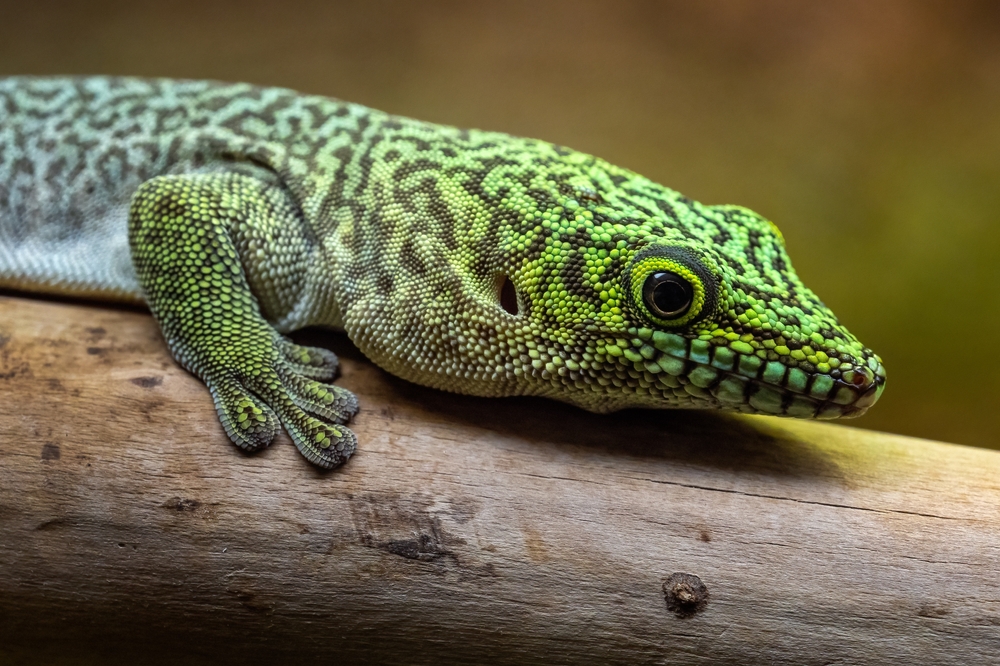Phelsuma standingi
Standing’s day geckos are far less popular now than they were in the 1990s. This species from Southwest Madagascar has intricate patterns across its entire body. It is considered a vulnerable species, with unregulated collection and deforestation as the primary driving forces for its decline. Juveniles are born with strong banding that covers their green/blue base colouration. As the lizard ages, this banding breaks up into an almost reticulated pattern. Like many Phelsuma species, they are listed under CITES Annex II.
Standings day geckos are highly variable. They can vary from strikingly coloured and dramatically patterned animals, to dull grey/brown lizards. This can also change throughout the day. Nutrition and lighting will undoubtedly play a large part in this.
Standings Day Gecko Housing
Standings day geckos are reasonably active and are amongst the larger Phelsuma species. They are best housed solitarily and will live comfortably in a 60x60x45 glass terrarium.
Ensure to place plenty of basking opportunities. As Standings’ day geckos are from a far drier region of Madagascar when compared to other, more popular, day geckos it is important to give them open areas with hot and dry basking spots, as well as cooler, more humid areas and hides.
Phelsuma Heating, Lighting and Humidity
Standings’ day geckos need high UVI and a basking spot of 35℃. This can be achieved with a Metal Halide Bulb creating a column of heat/light or a T5 bulb emitting UVB alongside a spot bulb producing heat.
Décor must be positioned so that the gecko can bask at various heights beneath the basking spot and move close to or further from the heat.
An ambient temperature of 22 – 25℃ is optimal. Humidity should spike and fall, but as these particular geckos inhabit the tropical forests of eastern Madagascar, maintaining humidity of +70% is advised.
A misting system can be used, or regular (twice daily) hand-spraying can achieve similar results. The geckos will drink from droplets in the environment, so ensure the water is clean and dechlorinated.
Bioactive vs Naturalistic
Phelsuma species are arboreal. Decor, bamboo and broad-leaved plants are necessary to allow them to bask and use the full space within the terrarium. Substrate is not essential, but it does help hold humidity and plants can grow directly from the substrate.
Standings day gecko is a robust species. The keeper should be sure the decor is firmly placed.
Fast-growing climbing plants like Philodendron scandens and tall, broad-leaved plants like Peace Lillies are great for day-gecko enclosures.
Phelsuma Diet
Standings day geckos are omnivorous. They eat mostly fruit, berries and nectar. Day geckos will also occasionally eat flying insects and pollen (from flowers and pollinating insects).
Research suggests brightly-coloured nectars are most appealing. Many Phelsuma species are adaptable and feed on a variety of fruits and nectars, including non-native ones. In urban environments where sugar is artificially high, only 2% of their diet may consist of insects.
In captivity, day geckos should be fed a high-sucrose, fragrant solution containing all the necessary vitamins and minerals such as Phelsuma Passion. We recommend this because even wild Phelsuma are drawn to chocolates and sugar, so it is paramount that a reliable brand is selected.
If a nutritionally complete diet is provided, non-nutritious insects can be offered. Flying insects, like black soldier flies, wax moths and silk moths offer great enrichment for active geckos to chase.
To get the very brightest colours from Standings’ day geckos, one should select a complete diet and ensure all feeder insects are dusted with a multivitamin containing carotenoids. You can learn more about multivitamin components and their influence on animals here.
